The holidays are full of fun, family, and food — and sometimes that means a table loaded with rich dishes and sweet treats. It’s easy to feel like your only choices are to either “be good” and miss out or give in and regret it later. The truth? You can enjoy holiday meals without guilt or deprivation. With a little planning and some mindful strategies, you’ll feel satisfied and energized while still enjoying the foods you love.
Planning Balanced Holiday Meals
Holiday meals don’t have to be an all-or-nothing event. A balanced plate lets you enjoy your favorites while keeping your well-being in mind.
Creating Balanced Menus
When building your holiday plate, think about balance. Fill half your plate with colorful fruits and veggies to pack in fiber and vitamins. Then, add lean proteins like turkey, chicken, or fish, plus a serving of whole grains such as quinoa or brown rice for lasting energy.
Try to keep foods high in added sugars, sodium, and saturated fat to smaller portions. Flavor your dishes with herbs and spices instead of extra salt or butter. Small tweaks like these can make holiday meals just as tasty while giving your body the nutrients it needs.
(For more ideas, check out these six healthy holiday eating strategies).
Ingredient Swaps for Nutrition
Simple swaps can make your holiday favorites a little lighter without losing the comfort and flavor:
- Use olive oil or avocado oil instead of butter for cooking.
- Swap heavy cream for Greek yogurt or low-fat milk in sauces.
- Choose whole-wheat flour for baked goods to add fiber.
- Pick fresh or frozen vegetables instead of canned to cut down on sodium.
Even desserts can get a glow-up — fruit-based options or smaller slices of pie can hit the spot while keeping sugar in check.
Portion Control Strategies
Portions often grow during the holidays, and that’s where the trouble starts. Using a smaller plate, filling half of it with veggies first, and eating slowly can help you avoid that “too full” feeling. Try waiting about 10 minutes before going back for seconds — sometimes your brain just needs time to catch up and realize you’re satisfied.
Mindful Eating Techniques
Mindful eating isn’t about restriction; it’s about awareness. Taking time to savor your food helps you enjoy the flavors and notice when you’re full.
- Eat without distractions (yes, that means putting the phone down).
- Pause and ask yourself if you’re truly hungry or just eating because the food is there.
- Treat yourself with intention — pick the holiday desserts you love most and savor them slowly.
Mindful eating can help you reset without restriction. If you’d like more strategies, explore our post on mindful eating after the holidays.
Staying Hydrated and Moderating Alcohol
It’s common to mistake thirst for hunger, especially at parties. Drinking water before and during meals can help you feel satisfied and support digestion. Alcohol, on the other hand, can lower your willpower and increase your appetite. If you’re drinking, alternate with water and limit sugary mixers to keep calories in check.
Enjoying Treats Without Guilt
You can enjoy holiday treats by planning ahead. Pick your favorite indulgences and savor them slowly. Focus on quality, not quantity, so you feel satisfied with smaller portions.
Avoid eating treats quickly or without paying attention. Savor each bite and note the flavors. This helps reduce the desire to eat more because you feel more fulfilled.
If you want desserts, try sharing them with others or choosing lighter versions. Remember that moderation helps maintain your health without cutting out enjoyment completely. Mindful eating lets you enjoy food without guilt or stress.
Supporting Healthy Habits Beyond Food
Your holiday health isn’t just about what’s on your plate. Exercise, sleep, and stress management all play a big role.
- Stay active: Even short bursts of movement — like a 10-minute walk after dinner — can improve energy and mood.
- Prioritize sleep: Aim for 7–9 hours. Lack of rest can make cravings stronger and portion control harder.
- Manage stress: The holidays can get hectic. Set realistic expectations, take breaks, and practice relaxation techniques to keep stress (and stress eating) in check.
The Bottom Line
Healthy holiday eating isn’t about saying no to everything that looks good. It’s about balance, mindfulness, and knowing which treats matter most to you. With a few simple shifts, you can enjoy festive meals, feel good about your choices, and start the new year with energy and confidence.
Sources
- Centers for Disease Control and Prevention. Healthy Holidays: Tips for a Healthy Holiday Season.
- Harvard T.H. Chan School of Public Health. The Nutrition Source: 6 Holiday Tips to Indulge Without Overindulging

